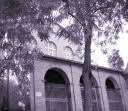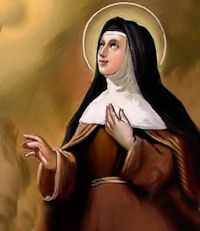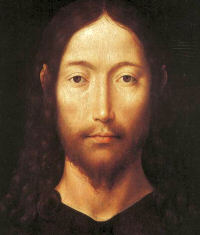Lent: March 6th
Tuesday of the Second Week of Lent
Other Commemorations: St. Colette, Virgin and Religious (RM)
» Enjoy our Liturgical Seasons series of e-books!
When you spread out your hands, I close my eyes to you; Though you pray the more, I will not listen. Your hands are full of blood! Wash yourselves clean! Put away your misdeeds from before my eyes; cease doing evil; learn to do good. Make justice your aim: redress the wronged, hear the orphan's plea, defend the widow. Come now, let us set things right, says the LORD: Though your sins be like scarlet, they may become white as snow; Though they be crimson red, they may become white as wool (Isaiah 1:15-19).
The clear will of God is the light and the salvation of all men. No one can desire anything good unless God desires it. Even the best of intentions, even seemingly worthy projects, are no good if they are not God's will at the moment. Distress, suffering, even death, can be accepted as His mysterious will. His creative love is always at work drawing the greatest possible good out of everything. Be the humble servant of God's will and you will be truly wise and always at peace. — Daily Missal of the Mystical Body

The Station today is at St. Balbina's, virgin and martyr (130), the daughter of the tribune and martyr, St. Quirinus. The church is ancient, and was probably built in the 4th century above the house of the consul Lucius Fabius Cilone. The first reference to it is found in a 6th century document, where it is referred to as Sanctae Balbinae. It was consecrated by Pope St. Gregory the Great.
Meditation: One Is Your Father
One is your Father, who is in heaven; one is your teacher, Christ; you are all brothers!
In these words lies embedded the basic structure of Christian common life. The Christian ideal, life with the Church, is emphasized.
- First, the Fatherhood of God. God is the head of the family. For the early Christians it was a new and thrilling experience to be able to address God as Abba, Father. Down to the present time this approach to God is peculiarly Christian. There is here no juridical balance between accomplishment and merit, but a predominance of grace and love. Perhaps we have grown too accustomed to this unique privilege to be duly impressed. God is our Father, we His children. To be a child of God is to have high rank through grace; this is our nobility. Lent should deepen this Father-child relationship, should increase our confidence in God's fatherly goodness and care, should deepen our spirit of obedience and childlike reverence.
- Christ is our teacher and master. We are called Christians, but do we always act so as to deserve the name? Do we give constant attention to maintaining our Christian dignity? Are we humble enough to learn from Christ, as willing pupils? His message comes to us most clearly in the Gospel. A good student would never tire of examining the Gospel and following in his master's footsteps. Christ speaks to us also through His priests, in the Church. Let us hold fast His doctrine, and esteem His commands, especially His principal commandment, love. No longer I, but Christ lives in me!
- We are all brothers! We are God's great family, bound by a strong, common bond. Community is the word we have rediscovered-community in prayer, in sacrifice, in common action. We must make this truth operative in every group of which we are part, e.g., family, business, factory, parish, state! But what special significance this truth assumes at divine services, at holy Mass! There we are grouped around our teacher, Christ. We are His members, and He leads us to the Father. Yes, in the Sacrifice of the Mass all three are together: Father, teacher, and brothers.
St. Colette
 Born in 1380, Nicolette was named in honor of St. Nicholas of Myra. Her loving parents nicknamed her Colette from the time she was a baby. Colette's father was a carpenter at an abbey in Picardy. Quiet and hard-working, Colette was a big help to her mother with the housework. Her parents noticed the child's liking for prayer and her sensitive, loving nature.
Born in 1380, Nicolette was named in honor of St. Nicholas of Myra. Her loving parents nicknamed her Colette from the time she was a baby. Colette's father was a carpenter at an abbey in Picardy. Quiet and hard-working, Colette was a big help to her mother with the housework. Her parents noticed the child's liking for prayer and her sensitive, loving nature.
When Colette was seventeen, both her parents died. The young woman was placed under the care of the abbot at the monastery where her father had worked. She asked for and received a hut built next to the abbey church. Colette lived there. She spent her time praying and sacrificing for Jesus' Church. More and more people found out about this holy young woman. They went to see her and asked her advice about important problems. They knew that she was wise because she lived close to God. She received everybody with gentle kindness. After each visit, she would pray that her visitors would find peace of soul. Colette was a member of the Third Order of St. Francis. She knew that the religious order of women who followed St. Francis' lifestyle are the Poor Clares. They are named after St. Clare, their foundress, who was a follower of St. Francis. During Colette's time, the Poor Clares needed to go back to the original purpose of their order. St. Francis of Assisi appeared to Colette and asked her to reform the Poor Clares. She must have been surprised and afraid of such a difficult task. But she trusted in God's grace. Colette traveled to the Poor Clare convents. She helped the nuns become more poor and prayerful.
The Poor Clares were inspired by St. Colette's life. She had a great devotion to Jesus in the Eucharist. She also spent time frequently meditating on the passion and death of Jesus. She loved Jesus and her religious vocation very much.
Colette knew exactly when and where she was going to die. She died in one of her convents in Ghent, Flanders, in 1447. She was sixty-seven. Colette was proclaimed a saint by Pope Pius VI in 1807.
—Excerpted from Holy Spirit Interactive
Symbols and Representation: birds; lamb; woman being carried to heaven by an angel; woman delivering a soul from purgatory; Poor Clare nun holding a crucifix and a hook; Poor Clare nun visited by Saint Anne, Saint Francis of Assisi, and/or Saint Clare of Assisi in a vision; Poor Clare nun walking on a stream
Patronage: against eye disorders; against fever; against headaches; against infertility; against the death of parents; craftsmen; Poor Clares; servants; Corbie, France; Ghent, Belgium
Highlights and Things to Do:
- Read more about St. Colette:
- The Colettines are a reformed branch of the Poor Clares. See the Ty Mam Duw Poor Clare Colettine Community for an example of one of the communities.
- St. Colette's relics are at Monastère Sainte-Claire in Poligny, France.






